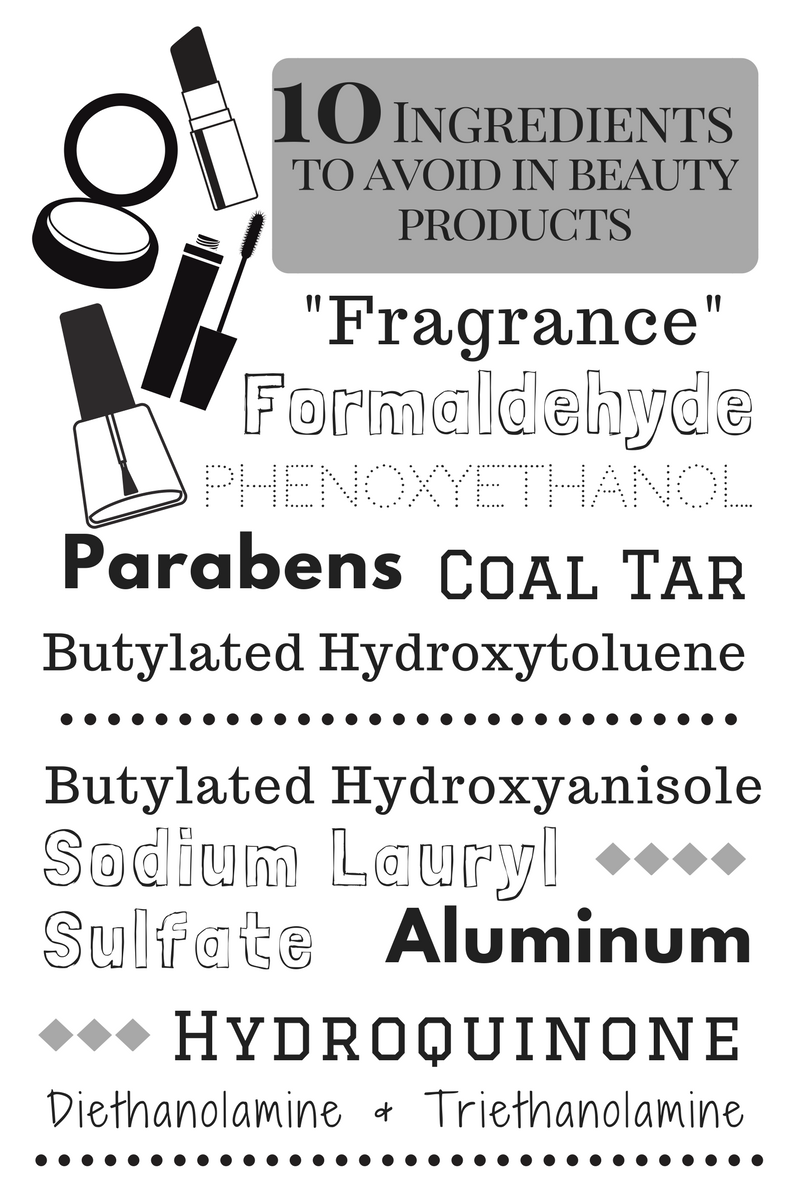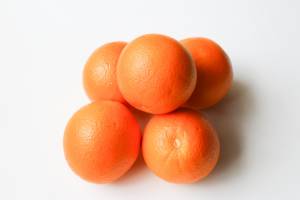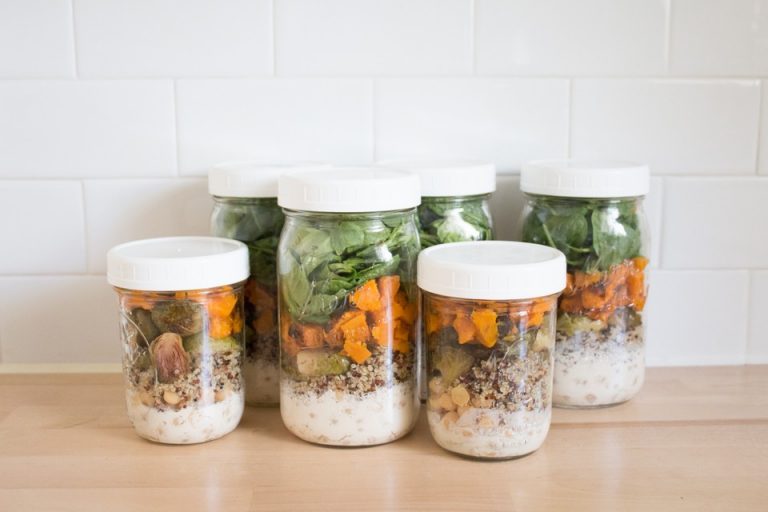A BIG part of the LSN Philosophy is becoming aware of the products we use, and not just products pertaining to food but the products we use for our body as well, like beauty products. And since the natural beauty industry has come such a long way over the past few years, there’s no reason why shouldn’t be using nourishing, natural, organic, and cruelty-free products, for our health and the health of the planet! Before we dive into what products we can use, I thought we would focus some attention on what ingredients we should avoid in our makeup and other beauty products. If you aren’t one to read labels, or can’t quite get yourself into the habit of it, hopefully, this article inspires you to start doing so.
Top 10 Ingredients to Avoid in Beauty Products
If we really want to be feeling and functioning at our very best we need to care about ourselves from the inside out AND the outside in. This means being mindful of what we put ON our bodies, as well as what we put IN our bodies. Yes, it’s time to turn over that pretty packaging and familiarize yourself with all those big words we can’t pronounce, ie. TOXINS!
If you won’t eat it, then it doesn’t belong on your skin.
That gorgeous skin you’re wrapped in is your largest organ and when we apply toxic chemicals to our skin it’s actually more harmful than putting them on a plate and eating them for breakfast. Why? Because your skin absorbs up to 60% of the ingredients you place on it and it goes straight to the bloodstream, avoiding all the filters our body has to keep us healthy and remove any unwanted toxins.
Today’s post is all about my top ten ingredients to should avoid, how to recognize unwanted ingredients, and how those ingredients affect the body.
 LSN’s Top 10 Ingredients to Avoid in Beauty Products
LSN’s Top 10 Ingredients to Avoid in Beauty Products
01. Fragrance
Found in: moisturizers, deodorants, lotions, face creams, shampoos, and conditioners.
Other names: The FDA doesn’t require companies to label any of the chemicals in their fragrance mixture. Recent research from the Environmental Working Group and the Campaign for Safe Cosmetics found an average of 14 chemicals in 17 name-brand fragrance products, none of them listed on the label. The term “fragrance” can stand for thousands of different ingredients (literally, at least 3,000).
Side effects: Fragrances can contain hormone disruptors and can increase the risk of cancer, birth defects, central nervous system disorders, and allergic reactions. I always recommend buying fragrance-free whenever possible and if you want to add your own natural fragrances use your favorite essential oils after purchase.
02. Parabens
Found in: makeup, moisturizer, shaving gel, shampoo, personal lubricants, and spray tan products.
Other names: butylparaben, ethylparaben, isobutylparaben, isopropylparaben, methylparaben, propylparaben. Look for ingredients with the suffix “-paraben” as well—paraben-free products will be labeled as such.
Side effects: The FDA acknowledges several studies linking parabens to breast cancer, skin cancer, and decreased sperm count, but has not ruled that it is harmful. According to the European Commission’s Scientific Committee on Consumer Products, longer-chain parabens like propyl and butyl paraben and their branched counterparts, isopropyl, and isobutyl parabens, mimic estrogen and may disrupt the endocrine system and cause reproductive and developmental disorders.
03. Coal Tar
Found in: Shampoos and scalp treatments, soaps, hair dyes, lotions,
Other names: Coal tar solution, tar, coal, carbo-cort, coal tar solution, coal tar solution USP, crude coal tar, estar, impervotar, KC 261, lavatar, picis carbonis, naphtha, high solvent naphtha, naphtha distillate, benzin B70, petroleum benzin.
Side effects: Coal tar is a known human carcinogen, according to the National Toxicology Program and the International Agency for Research on Cancer. Coal tar has also been associated with cancer of the lung, bladder, kidney, and digestive tract. Other effects include emotional and sleep disturbances, as well as loss of coordination.
04. Aluminum
Found in: Eyeshadow, eye pencil, deodorant, antiperspirants, lip balm, shampoo & conditioner, nail polish, and waterproof mascara.
Other names: Aluminum, aluminum flake, LB Pigment 5, Pigment Metal 1, A 00, A 95, A 995, A 999, AA 1099, or AA 1199.
Side effects: Some studies show that people exposed to high levels of aluminum may develop Alzheimer’s disease, but other studies have not found this to be true. Unfortunately, we don’t know for certain but it is often linked to Alzheimer’s and brain disorders and is a possible risk factor in breast cancer.
05. Formaldehyde
Found in: Nail polish, nail glue, eyelash glue, hair gel, hair-smoothing products, baby shampoo, body soap, body wash, and color cosmetics.
Other names: Formaldehyde, quaternium-15, DMDM hydantoin, imidazolidinyl urea, diazolidinyl urea, polyoxymethylene urea, sodium hydroxymethylglycinate, 2-bromo-2-nitropropane-1,3-diol (bromopol) and glyoxal.
Side effects: Formaldehyde is considered a known human carcinogen and has been linked to cancer, but there is little evidence that it directly causes cancer. When formaldehyde is present in products, people can be exposed by inhaling the formaldehyde, by ingesting it or by absorbing it through the skin. Formaldehyde in cosmetics is widely known to cause allergic skin reactions and rashes in some people.
06. Sodium Laurel/Laureth Sulfate
Found in: Shampoo, body wash, foundation, face wash, mouthwash, and toothpaste.
Other names: Monododecyl ester sodium salt sulfuric acid, sodium dodecyl sulfate, sodium dodecyl sulfate, sodium lauryl sulfate, sodium salt sulfuric acid, monododecyl ester, sulfuric acid monododecyl ester sodium salt, sulfuric acid, monododecyl ester, sodium salt, ai3-00356, akyposal sds, aquarex me, aquarex methyl.
Side effects: A commonly used foaming agent that is considered a skin irritant and carcinogen, and is known to cause skin rashes and allergic reactions. SLS is absorbed into the body via skin application and mimics the activity of estrogen. SLS has been shown to cause or contribute to skin irritation, canker sores, disruptions of the skin’s natural oil balance, and eye damage. Other health implications range from PMS, and decreased fertility in men as well as an increase in cancers such as breast cancer in women. It is often disguised in “natural” products with the term “derived from coconut”. It is particularly irritating to the eyes. SLS is often contaminated with dioxane, another known carcinogen.
07. Diethanolamine (DEA) and Triethanolamine (TEA)
Found in: Soaps, shampoos, hair conditioners and dyes, lotions, shaving creams, pharmaceutical ointments, eyeliners, mascara, eye shadows, blush, foundations, fragrances, and sunscreens.
Other names: Triethanolamine, diethanolamine, DEA, TEA, cocamide DEA, cocamide MEA, DEA-cetyl phosphate, DEA oleth-3 phosphate, lauramide DEA, linoleamide MEA, myristamide DEA, oleamide DEA, stearamide MEA, TEA-lauryl sulfate.
Side effects: The European Commission prohibits DEA in cosmetics due to concerns about the formation of carcinogenic nitrosamines. These chemicals can react with other ingredients in the cosmetic product to form potent carcinogenic chemicals called nitrosamines, which are linked with liver, stomach, bladder, and esophagus cancers. Studies have found that DEA affects human male reproductive health. Another study suggests that memory function and brain development in offspring could be permanently affected by mothers’ exposure to DEA.
08. Phenoxyethanol
Found in: Moisturizer, eye shadow, foundation, sunscreen, conditioner, mascara, eyeliner, shampoo, lip gloss, concealer, body wash, hand cream, blush, hair color, hair spray, lip balm, lotion, nail polish, baby wipes, baby lotions and soaps, soap (liquid and bar), shaving cream, deodorant, toothpaste, fragrance, hair removal waxes, and hand sanitizer.
Other names:Phenoxyethanol, 2-Phenoxyethanol, Euxyl K® 400 (mixture of Phenoxyethanol and 1,2-dibromo-2,4-dicyanobutane), PhE.
Side effects: Phenoxyethanol is used as a preservative in cosmetic products and also as a stabilizer in perfumes and soaps. Exposure to phenoxyethanol has been linked to reactions ranging from eczema to severe, life-threatening allergic reactions.
09. Butylated Hydroxyanisole (BHA) and Butylated Hydroxytoluene (BHT)
Found in: Lip products, hair products, makeup, sunscreen, antiperspirant/deodorant, fragrance, creams, and exfoliates.
Other names: BHA, BHT
Side effects: The European Commission on Endocrine Disruption has determined that there is strong evidence that BHA is a human endocrine disruptor. Used as a preservative, BHA and BHT can induce allergic reactions in the skin, the underdevelopment of the reproductive systems, and changes in testosterone levels.
10. Hydroquinone
Found in: Skin lighteners, facial and skin cleansers, facial moisturizers, hair conditioners, fingernail coating products.
Other names: Hydroquinone or tocopheryl acetate.
Side effects: Hydroquinone is most commonly used in skin lighteners, products heavily marketed towards women of color or those suffering from sun spots. It is linked to cancer and organ-system toxicity. It works by decreasing the production and increasing the degradation of melanin pigments in the skin. This increases the skin’s exposure to UVA and UVB rays, risking skin cancer and a condition called ochronosis in which the skin (our largest organ) thickens and turns bluish-grey. Hydroquinone can be harmful if inhaled, causing irritation of the nose, throat, and upper respiratory tract.
Other Ingredients to Avoid: Nanoparticles, Oxybenzone, Mica, Tetrasodium EDTA, Cyclomethicone, Cyclopentasiloxane, Dimethicone Copolyol, Dioxins, Dimethicone, Methicone, Phenyl Trimethicone, Toluene.
LSN’s Top Resources For Natural Beauty Consumers
Check out these additional resources for more great info:
EWG’s Skin Deep is leading the industry in terms of resources to help consumers make accurate assessments about the safety of their products. This was my go-to starting point and I reference the site and app often (EWG’s App is now called “Healthy Living”). With breakthrough research and education, they aim to drive consumer choice and provide you with easy-to-navigate ratings for a wide range of products and ingredients on the market.
Think Dirty® is an app committed to helping consumers identify the potential risks associated with the personal care products they use every day. They focus exclusively on the chemical content of the products in question. The app allows users to scan UPC codes or look up products on the market to receive a rating from 1-10 for toxicity (I recommend staying between a score of 5 and under). They also include links to research and studies of ingredients.
The Campaign for Safe Cosmetics coalition is a project of Breast Cancer Prevention Partners (formerly the Breast Cancer Fund), working to protect the health of consumers, workers, and the environment through public education, corporate accountability and sustainability campaigns focused on eliminating dangerous chemicals from cosmetics and personal care products.
The Story of Cosmetics
I’m happy I got this post up for you all to use for your natural beauty product reviews. I hope you find it helpful when shopping for beauty products in the future. This is my personal list that I turn to when looking at new beauty products. Stay tuned for more natural living tips :)
Hugs,

The information in this post is an accumulation of my own research and experience. It is not intended to be a substitute for medical advice, diagnosis, or treatment. Always seek the advice of your physician or a qualified health provider. If you have any other questions email me at Vanessa@LiveSimplyNatural.com and I’ll answer them to the best of my ability.
Sources:











3 Comments
Most people don’t know that shampoos that grow your hair fast (of course without any sulfates, parabens or DEA) are a thing. Folks can now attain longer hair and enjoy more alternatives. Undoubtedly worth looking up.
Whether you’re talking about hair loss, hair damage, preventing scalp disorders, fast hair growth, hair care more often than not, almost the same rules apply.
Generally, you should try to steer clear of hair treatments and products that include chemicals like parabens, DEA and sulfates.
What’s beneficial for your hair is good for your skin also.
For obvious reasons your content on this page hits the nail in the head for multiple reasons. It steers away from the usual pitfalls and traps so many fall into- using horrible alternatives. Thank you!
Great post! Have nice day ! :)